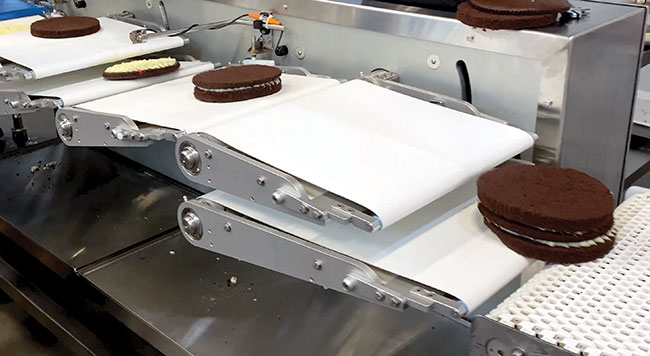
The automation decision
May 25, 2022
By Jamie Bobyk, Apex Motion Control
When is it best to automate if you are a small, growing business?
 You may consider automating the cake-layering process with a conveyor so that the layers are handled less, and consistently stacked on top of one another. Photo: Apex Motion Control
You may consider automating the cake-layering process with a conveyor so that the layers are handled less, and consistently stacked on top of one another. Photo: Apex Motion Control When is it best to automate if you are a small, growing baking business?
Automation is never a one-size-fits-all. When it comes time to decide on which processes to automate, or even semi-automate, it generally comes down to a few contributing ingredients: production throughput, quality, consistency and delivery times.
And remember, even though there may be a general consensus that it’s time to automate, seeing this automation in action may still be up to a year away, or even more depending on the depth of automation you are wishing to implement.
Being proactive pays off. Put together a list of products or processes you wish to automate, then start having conversations with equipment manufacturers. Have a sales rep come and walk your production floor and provide consultations on where, when and what it makes sense to automate.
Look for equipment that grows with your business and equipment that is versatile. For example, Apex Motion Control’s Baker-Bot can be easily moved throughout your facility and automates such processes as tray handling — moving trays from a conveyor to a baker’s rack or from a baker’s rack to a conveyor and helping decorate cakes and cookies by simply drawing your pattern on a tablet.
Cost
Always consider and look for equipment that offers a quick return on investment. But how quick is quick?
This is where you will need to do some math. Calculate the costs associated with the process or processes you want to automate. Labour, ingredient waste, training, labour, injuries, shortages/overtime…you get the picture. When comparing manual labour and automation, it generally takes about a year (sometimes more, sometimes less) to start seeing your return on investment pay directly to your bottom line.
Keep in mind that there are choices available for leasing or rent-to-own equipment options.
Space
Do you have the space in your current facility to implement automation equipment or will you have to consider expanding or even moving? If you are tight on space and are not ready to move, look at equipment that can do the job within a small footprint. Automation doesn’t mean giant production lines with miles of conveyors and equipment. With so much technology available today, automation can even be the size of a person, like Collaborative Robots, or Cobots, for example. More often than not, you will be able to find equipment that will work within your space constraints.
Watch and listen
Sometimes your best tool for gauging when to automate is your team of production workers. What are they saying? Are they calling in sick more often, producing inconsistent products, working a lot of overtime, filing more injury claims or exhibiting low morale? It’s one thing to be aware of the throughput of your production floor, but it’s another thing to also be aware and attentive to how this throughput is actually being accomplished.
There will be resistance from some of the staff out of fear of losing their job or being replaced by a machine. This is your opportunity to repurpose your workers to more value-added positions. It’s a win-win situation.
Consistency
One of the biggest advantages in automating is an uptick in the consistency of your products. Equipment does not think or bring emotions or decisions into repetitive tasks. A piece of equipment is programmed and it repeats that exact task each and every time. For example, removing the labour-intensive and sensitive task of layering cake layers on top of another iced layer of cake as it moves down a conveyor line. This poses risk for repetitive stress and breakage (ingredient loss).
Instead, consider automating this process with a cake-layering conveyor so that the layers are handled less, and consistently stacked on top of one another as they move down the line to the icing and decorating area . . . which, by the way, can also be automated.
While there are many obstacles and factors to consider before, during and after, automation can be your most effective tool when looking to increase production, help with labour shortages and control repetitive stress injuries all while creating a consistent product. / BJ
Print this page